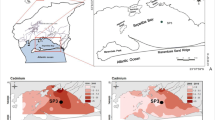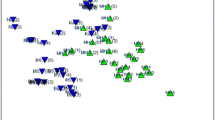Abstract
Aim and background
In the process of creating safe navigable waterways for oil exploitation, the companies operating in the Niger Delta generate tons of sulfidic spoils. These are often deposited over bank, mostly upon fringing mangroves, and abandoned. This leads to a myriad of environmental problems. The extent of these impacts is not exactly known, but was inferred from the activities of oil companies operating in the area. This paper describes the impacts following the disturbance of sulfidic sediment through dredging and by subsequent poor spoil management practices.
Environmental impacts of exposed and abandoned sulfidic sediments. The practice of dumping and abandoning sulfidic dredged spoils along canal banks triggers a series of environmental problems leading to extreme acidification, heavy metal pollution, and general habitat degradation which prevent the re-colonization of the sites by native species. The resultant spoil dumps remain bare for several years and they become colonized by invasive species later. Later still they may become attractive to the local population as sites for houses, fishing camps and home gardens, which is nevertheless regarded as a positive impact.
Management of abandoned sulfidic spoil dumps. As a panacea to environmental problems caused by the sulfidic spoils, they need to be properly handled to prevent their acidification. This should be followed by mangrove restoration to pristine conditions or rehabilitation to other beneficial uses.
Conclusion and Recommendation. The abandoned sulfidic spoils in the Niger Delta have resulted in the death of several thousands of hectares of mangrove habitat and their associated biota. Despite the increasing scale of dredging and spoil abandonment, the accompanying problems have been recognized by neither the oil companies nor by national government. This paper attempts to highlight these problems and concludes by recommending sound spoil management strategies involving the handling, restoration and rehabilitation of impacted areas. Furthermore, possible beneficial use of dredged spoils for civil construction, beach nourishment / shoreline protection is identified. The Nigerian Government needs to promulgate and enforce laws that will permit the sustainable use of mangrove resources.
Similar content being viewed by others
References
Ainodion MJ, Robnet CR, Ajose TI (2002): Mangrove restoration by an operating company in the Niger Delta. Presented at the Society for Petroleum Engineers (SPE) International Conference on Safety and Environment in Oil and Gas Production held in Kuala Lumpur, Malaysia, 20–22 March 2002. SPE Paper 74033
Anderson B (1966): Report on The Soils of The Niger Delta Special Area. Niger Delta Development Board, Port-Harcourt Nigeria
ASA (1998): Dredging Impact Study. A report submitted by Ade Sobande and Associates (ASA) to Shell Petroleum Development Company of Nigeria (SPDC), Warri
Asangwe CK (1993): Issues and problems in controlling the threats of erosion along the Nigerian Coastline. In: Awosika LF, Ibe AC, Shroader P (Eds): Coastlines of West Africa. American Society of Civil Engineers, New York pp. 309–324
Awosika LF, Ibe AC, Ibe CE (1993): Anthropogenic activities affecting sediment load balance along the West African Coastline. In: Awosika LF, Ibe AC, Shroader P (Eds.): Coastlines of West Africa. American Society of Civil Engineers, New York pp 40–53
Bowman GM (1993): Amelioration of potential acid sulphate soil by pyrite removal: Micala Island, New South Wales, Austrailia. In: Dent DL and van Mensvoort MEF: Selected paper of the Ho Chi Minh City symposium on Acid sulphate soil, Ho Chi Minh City, Vietnam, March 1992. International Institute for land Reclamation and improvement (ILRL), Wageningen, The Netherlands, 31–41
Bowman GM (1996): An overview of acid sulphate treatment. In: Proceedings of 2nd National Conference on Acid Sulphate Soils, Smith RJ, Smith HJ (Eds.). Robert J. Smith and Associates and ASSMAC, Australia. 200–206
Bramley RGV, Rimmer DL (1988): Dredge materials — Problems associated with their use on Land. J. Soil Science 39: 469–482
Delaune RD, Smith CJ (1985): Release of nutrients and heavy metals following oxidation of freshwater and saline sediments. J. Environ. Qual. 14: 164–168
Dugan PR, Apel WA (1983): Bacteria and acidic drainage from coal refuse. Inhibition by sodium lauryl sulphate and sodium benzoate. Appl. Environ. Microbial. 46: 279–282
Ebisemiju FS (1988): Human impacts on marine processes in the western Niger Delta. In: Sada PO, Odemerho FO: Environmental Issues and Management in Nigerian Development. Woye and Sons Press Ltd., Ilorin, Nigeria 239–251
Environment Australia (2001): International Study of the Effectiveness of Environmental Assessment — SPDC-East Liquefied Natural Gas (LNG) Supply Project, Nigeria. Environment Australia
ERML (1997): Environmental and Social Characteristics of the Niger Delta. Phase 1: Vol. 1. A report submitted by Environmental Resources Managers Limited to the Niger Delta Environmental Survey (NDES), Lagos
Fennessy SM, Mitsch WJ (1989): Design and use of wetlands for the renovation of drainage from coal mines. In: Mitsch WJ, Jorgensen SE (Eds.), Ecological Engineering: An Introduction, pp. 231–253. John Wiley and Sons, New York
Field CD (1996): Restoration of Mangrove Ecosystems. The International Tropical Timber Organization and the International Society for Mangrove Ecosystems
Hamilton LS, Snedaker SL (1984): Restoration and establishment. In: Handbook of Mangrove Area Management. East West Centre, Honolulu, Hawaii USA
Human Rights Watch (1999): The Price of Oil: Corporate Responsibility and Human Rights violations in Nigeria’s Oil Producing Communities. Human Rights Watch Washington DC
Ibe AC (1988): Coastlines erosions in Nigeria. Ibadan University Press
Indraratna B, Glamore WC, Tularam GA (2002): The effect of tidal buttering on acid sulphate soil environment in coastal area of New South Wales. Geotech. Geol Engr. 20: 181–199
Kaly UL, Jones GP (1998): Mangrove restoration, a potential tool for coastal management in developing conditions. Ambio 27: 656–661
Kathiresan K, Bingham BL (2001): Biology of mangrove ecosystems. Advances in Marine Biology 40: 81–251
Kleinmann RLP (1998): Bactericidal Control of Acidic Drainage. In: Brady KBC, Smith MW, Shueck J (Eds.): Coal Mine Drainage Prediction and Pollution in Pennsylvania, pp. 15–1 to 15–6. Department of Environmental Protection, Pennsylvania, USA
Lan Y, Huang X, Derg B (2002): Suppression of pyrite oxidation by iron 8-hydroxyquinoline. Arch. Environ. Contain Toxicol. 43: 168–174
Lewis RR (1982): Mangrove forests. In: Lewis RR (Ed.): Creations and restoration of Coastal Plant Communities. CRC Press, Boca Raton, USA
Minh LQ, Tuong TP, Van Mensvoort MEF, Bouma J (1997): Contamination of surface water as affected by land use in acid sulphate soils in the Mekong River, Vietnam. Agriculture, Ecosystem and Environment 61: 17–27
Moffat D, Linden O (1995): Perception and Reality: Assessing Sustainable Development in the Niger River Delta. Ambio 24, 527–538
Moore PA, van Breemen N, Patrick WH (1996): Effect of Drainage on the chemistry of acid sulphate soils. Agronomy Monograph No. 38: 1107–1123
Neil C, Turner RE (1987): Back-filling canals to mitigate wetland dredging Louisiana coastal marshes. Environ. Management 6: 823–836
Nwilo PC, Onuoha A (1993): Environmental impacts of human activities on the coastal areas of Nigeria. In: Awosika LF, Ibe AC, Shroader P (Eds.): Coastlines of West Africa. American Society of Civil Engineers, New York pp. 220–234
Ohimain EI (2001): Bioremediation of heavy metal contaminated dredge spoil from a mangrove ecosystem in the Niger Delta. Ph.D. Dissertation. University of Benin, Edo State, Nigeria
Ohimain EI (2002): Preservation of Niger Delta wetland resources through proper handling and rehabilitation of abandoned waste sulfidic dredge spoils. A paper presented at the National Conference on Environmental Science and Technology held at Greensboro September 8-10, 2002
Ohimain EI (2003): Available options for the bioremediation and restoration of abandoned pyritic dredge spoils causing the death of fringing mangroves in the Niger Delta. Accepted for presentation at the International Biohydrometallurgy Symposium (IBS 2003) in September 2003 in Athens, Greece
Ojo O, Awosika LF, Ibe AC (1993): Implications of environmental dynamics for sustainable environmental resources management futures in the Niger Delta. In: Awosika LF, Ibe AC, Shroader P (Eds.): Coastlines of West Africa. American Society of Civil Engineers, New York, pp. 268–282
Onysko SJ, Kleinmann RLP, Erickson PM (1984): Ferrous iron oxidation by Thiobacillus ferrooxidans: inhibition with benzoic acid, sorbic acid and sodium lauryl sulphate. Appl. Environ. Micribiol. 48: 229–231
Perry E, Holland L, Evans R, Schueck J, Maxwell D (1998): Special handling techniques in the prevention of acid mine drainage. In: Brady KBC, Smith MW, Shueck J (Eds.): Coal Mine Drainage Prediction and Pollution in Pennsylvania, pp. 14–1 to 14–22. Department of Environmental Protection, Pennsylvania, USA
Rastogi V (1996): Water quality reclamation management in mining using bactericides. Mining Engineering April: 71-76
Rose AW, Cravotta CA (1998): Geochemistry of coal mine drainage. In: Brady KBC, Smith MW, Shueck J (Eds.): Coal Mine Drainage Prediction and Pollution in Pennsylvania, pp. 1–1 to 1–22. Department of Environmental Protection, Pennsylvania, USA
Saffigna PG, Smith DJ, Holland GL, Brown GA, Carstens LW, Brown WJ (1996): Separation and remediation of saline Tween River sediments at Chinderah. In: Proceedings of 2nd National Conference on Acid Sulfate Soils, Smith RJ, Smith HJ (Eds.), pp. 206–214. Robert J. Smith and Associates and ASSMAC, Australia
Sammut J, Lines-Kelly R (2000): An Introduction to Acid Sulphate Soils. Natural Heritage Trust, Australia Seafood Industry and Environment Australia
Schippers A, Jazsa PA, Kovacs ZM, Jelea M, Sand W (2001): Large scale experiments for microbiological evaluation of measures for safe guarding sulfidic mine waste. Waste Management 21: 139–146
Schippers A, von Rege H and Sand W (1996): Impact of microbial diversity and sulphur chemistry on safeguarding sulfidic mine waste. Minerals Engineering 9: 1.069–1079.
Smith MW, Brady KBC (1998): Alkaline Addition. In: Brady KBC, Smith MW, Shueck J (Eds.): Coal Mine Drainage Prediction and Pollution in Pennsylvania, pp. 13–1 to 13–13. Department of Environmental Protection, Pennsylvania, USA
Southerland NM, Scott PA, Morton WK (1996): Field Practicalities of treating acid sulphate soils In: Proceedings of 2nd National Conference on Acid Sulfate Soils, Smith RJ, Smith HJ (Eds.). Robert J Smith and Associates and ASSMAC, Australia 221–226
Stevenson NJ, Lewis RR, Burbridge PR (1999): Disused shrimp pond and mangrove rehabilitation. In: Steever W (Ed.): An International Perspective on Wetland Rehabilitation. Kluwer Academic Publications, The Netherlands 277–297
Sylla M, Andriesse W (1994): An agro-ecological characterization of mangrove ecosystems in West Africa, with special emphasis on rice cultivation. In: Sylla M: Soil salinity and acidity: Spatial variability and effects on rice production in West Africa’s mangrove zone. PhD thesis Wageningen Agricultural University, Wageningen, The Netherlands, pp. 19–50
Sylla M, Stein A, Van Mensvoort MEF, Van Breemen N. (1996): Spatial variability of soils actual and potential acidity in the mangrove agroecosystems of West Africa. Soil Science Society of America Journal 60, 219–229
UNEP (1999): Regional overview of land based sources and activities affecting the coastal African region. UNEP/GPA Co-ordination Office &: West and East African Plan
USACE/WES (United States Army Corps of Engineers/ Waterways Experiment Station) (1998): Dredged material testing for beneficial use suitability. Tech. Note DOER-C2. USACE / WES, Vicksberg
USEPA/USACE (1998): Evaluation of Dredged Material Proposed for Discharge in Waters of the US. Inland testing manual report No. EPA- 823-398-004, 391 pp.
van Breemen N (1996): Genesis and solution chemistry of acid sulphate soils in Thailand. Agricultural Research Report 848. Centre for Agricultural Publishing and Documentation, Wageningen. The Netherlands
World Bank (1995): Defining an Environmental Development strategy for the Niger Delta. Volume 1. West Central Africa Department, Washington DC
World Conservation Union (IUCN) (1993): Oil and gas Exploration and Production in Mangrove Areas. IUCN, Gland, Switzerland, 47 pp.
Author information
Authors and Affiliations
Corresponding authors
Rights and permissions
About this article
Cite this article
Ohimain, E.I., Andriesse, W. & van Mensvoort, M.E. Environmental impacts of abandoned dredged soils and sediments. J Soils & Sediments 4, 59–65 (2004). https://doi.org/10.1007/BF02990830
Received:
Accepted:
Issue Date:
DOI: https://doi.org/10.1007/BF02990830




